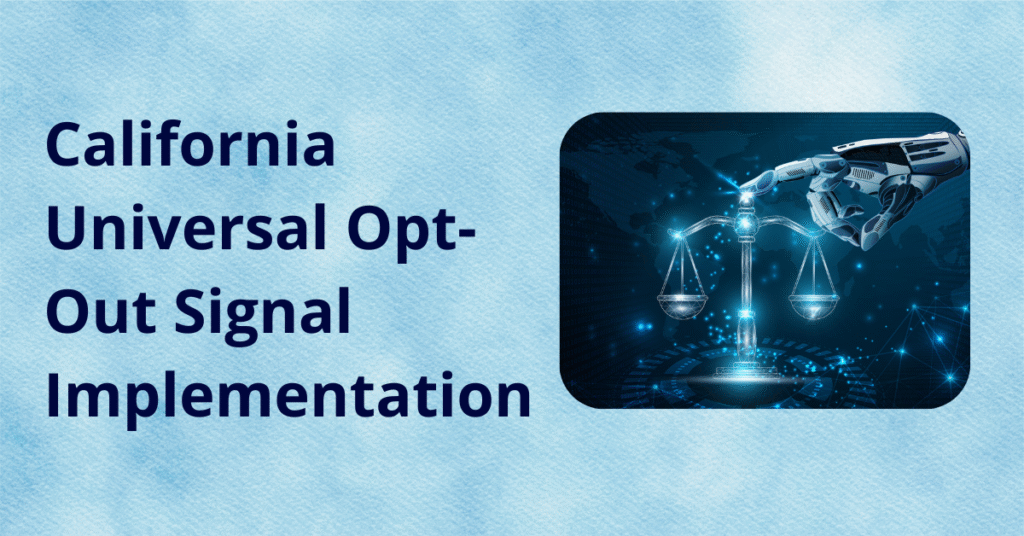
Key Takeaways
- The new opt-out signal adds complex browser and backend demands.
- Cross-browser and GPC alignment will decide success.
- Marketers must link privacy signals to consent workflows.
- CPPA rules will shape technical compliance standards.
- Privacy-first systems are now core to marketing strategy.
The California Opt-out Signal marks a defining shift in privacy technology and compliance readiness. What appears to be a simple browser setting for users hides an intricate challenge for browser developers, marketers, and compliance teams. A single signal now requires diverse systems, platforms, and consent frameworks to take action automatically — and it must do so reliably.
For consumers, this initiative represents convenience and empowerment. For businesses, it raises a question of readiness. How will they detect, process, and honor this new form of consent preference declaration? The coming years will test how well technology can serve both privacy rights and marketing realities in one connected ecosystem.
What is the California Opt-Out Signal?
At its core, the California Opt-out Signal is a standardized communication mechanism. It allows a browser to tell every website a user visits that they have chosen not to have their data sold or shared. Under California’s updated privacy framework, this single signal will carry the same legal weight as a site-specific opt-out request.
This system builds on existing privacy initiatives like Global Privacy Control (GPC), a browser-based specification already recognized under the California Consumer Privacy Act. The difference now is that browsers will be required by law to implement it, and businesses must treat the California Opt-out Signal as a binding consumer preference.
While the intent is clarity, implementation will be complex. Every browser vendor must design a feature that is easy to use, compliant with California privacy law, and interoperable with the broader web. The real test will come when these signals meet thousands of websites built on different architectures, consent management platforms, and marketing stacks.
Why this Simplicity Could be Challenging?
What seems simple for users translates to a series of interconnected technical hurdles for developers and organizations.
First, browsers must establish a consistent way to transmit the California Opt-out Signal. There are ongoing debates about whether this should follow the GPC specification or evolve into a broader privacy signal standardization framework. Without alignment, websites may face conflicting signals or interpretation issues.
Second, websites and consent management platforms will need to detect the incoming California Opt-out Signal automatically. This involves adding logic to recognize the preference, log it for audit purposes, and ensure that downstream systems such as CRM platforms, analytics tools, and data warehouses also respect it.
Third, the law’s lack of specificity around mobile environments creates additional uncertainty. Browser privacy engineering must account for how this signal functions on mobile browsers, in-app browsers, and hybrid web-views. Consistency across environments will be key to avoiding compliance gaps.
Fourth, organizations will need scalable opt-out signal handling processes. This includes validating signals, preventing data from being processed post opt-out, and ensuring synchronization across internal systems. For many, this will require rebuilding data flow logic that was designed for static cookie preferences rather than dynamic browser signals.
What are the CPPA Rulemaking and Regulatory Expectations?
The California Privacy Protection Agency (CPPA) will play a crucial role in shaping the technical reality of this law. Its upcoming rulemaking process will define what counts as compliant California Opt-out Signal handling, what audit trails are required, and how websites must respond to ambiguous or conflicting signals.
One major question is whether the agency will formally endorse a standard such as Global Privacy Control or create a new implementation guide. Either path carries risk. A new standard may add complexity, while adopting GPC could create compatibility issues if browsers interpret its parameters differently.
Businesses must prepare for iterative updates. As the CPPA refines its requirements, organizations will need flexible consent frameworks capable of adapting without full system rebuilds. This is where modular compliance architecture and privacy automation platforms will become invaluable.
How to Integrate Marketing with Consent Systems?
From a marketing operations standpoint, the California Opt-out Signal will force teams to rethink data collection strategies. Many organizations rely on consent management platforms (CMPs) that focus on form submissions. These tools will now need to integrate with browser-level signals.
The signal will likely be acknowledged on traditional contact forms confirming the user’s choice. This means processes must read, record, and enforce these preferences. Marketers, in turn, must ensure that suppression logic extends through all systems — from campaign orchestration to analytics.
A strong privacy-first marketing infrastructure will depend on automation. Systems must not only honor the California Opt-out Signal in real time but also prevent data reactivation or inadvertent use in later campaigns. Businesses will need to re-evaluate how they synchronize consent data across marketing automation tools like Marketo, Eloqua, and Salesforce Marketing Cloud.
The ultimate challenge lies in coordination. Marketing, legal, and IT teams must operate as one. When a browser-level opt-out arrives, every connected platform must respond consistently, or compliance risk increases. This shift moves privacy out of the legal department and into the core of marketing technology architecture.
Why is the Standardization Important?
A consistent technical language for privacy signals is essential. Without it, each browser could interpret the law differently, leaving websites to manage fragmented implementations. This scenario would mirror the early confusion around cookie consent standards, where inconsistent formats created user frustration and compliance gaps.
Privacy signal standardization efforts must focus on interoperability, clear metadata definitions, and open collaboration between browser vendors and compliance experts. Success depends on creating a system that works across Chrome, Safari, Firefox, and Edge while remaining compatible with mobile operating systems.
Such standardization would also support cross-jurisdictional compliance. As other U.S. states or even international regulators consider similar approaches, a shared foundation will simplify adaptation and enforcement. The lesson from global privacy evolution is clear: the earlier alignment happens, the smoother compliance becomes.
The Road Ahead
The California Opt-out Signal represents the next stage in the convergence of privacy, technology, and marketing. It challenges every organization to think differently about data responsibility and infrastructure readiness.
While compliance will demand investment, it also opens the door to greater efficiency and customer trust. A streamlined, browser-level consent process can reduce friction, demonstrate accountability, and enhance user confidence.
The most forward-thinking organizations will treat this not as a regulatory burden but as a competitive differentiator. Transparency and respect for privacy are becoming the new currencies of customer loyalty. By embracing this change early, marketers can redefine personalization around trust rather than tracking.
Conclusion
California Opt-out Signal is more than a new legal requirement. It is a stress test for the entire digital ecosystem. The simplicity it promises users depends on the complexity that businesses are willing to master behind the scenes.
As the CPPA refines the technical framework, organizations that invest now in privacy-first architecture will gain more than compliance — they will gain credibility. The future of marketing lies not in collecting more data but in using the right data, ethically and transparently.
At 4Thought Marketing, we help businesses strike a balance between privacy and performance. If your team is preparing for California’s upcoming browser signal mandate, connect with us to explore tailored solutions that align compliance with customer experience.
Frequently Asked Questions(FAQs)
1. What is the California Opt-Out Signal?
It is a legal requirement under California privacy law mandating browsers to send a signal when users choose to opt out of data sale or sharing across all websites.
2. How does this differ from existing consent tools?
Unlike traditional pop-ups or cookie banners, the California Opt-out Signal operates directly through the browser, automatically communicating the user’s privacy choice without extra steps on each website.
3. What role does the California Privacy Protection Agency play?
The CPPA will define the technical and operational standards for recognizing, processing, and honoring the California Opt-out Signal through its upcoming rulemaking process.
4. How should businesses prepare for compliance?
Organizations must update consent management systems, ensure signal handling across platforms, and integrate automation to enforce privacy choices consistently.
5. What are the key challenges for marketers and developers?
The main challenges include browser privacy engineering, interoperability with Global Privacy Control (GPC), and ensuring compliance across data pipelines and analytics systems.
6. Could this law influence global privacy practices?
Yes. Because major browsers are global, California Opt-out Signal could become a worldwide model for browser privacy standards and universal consent handling.





